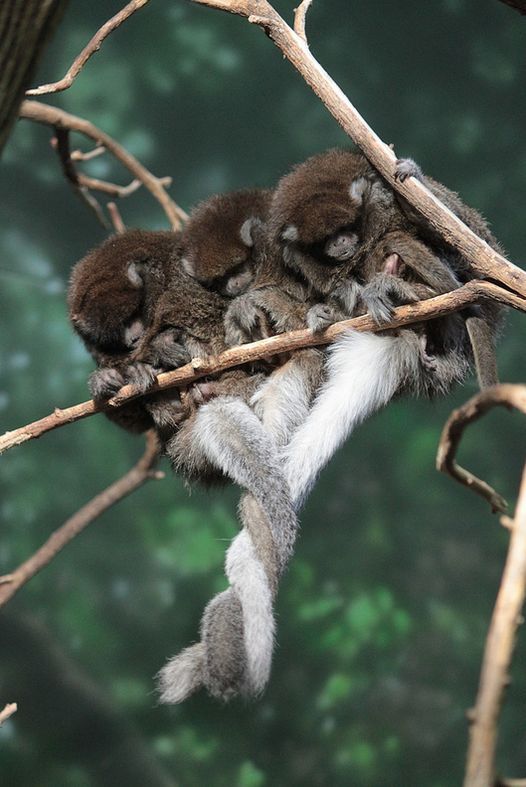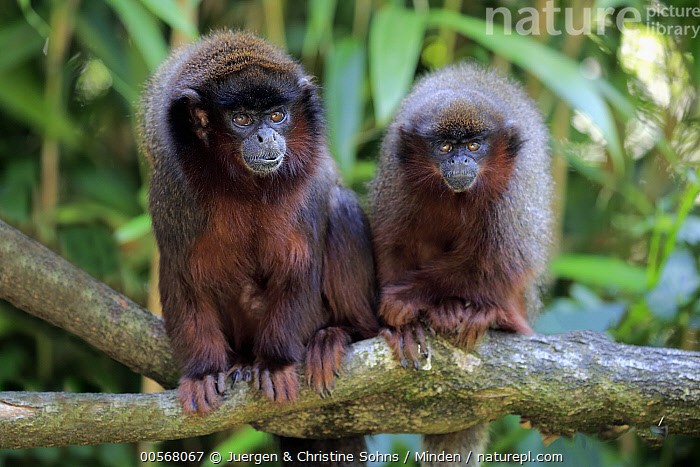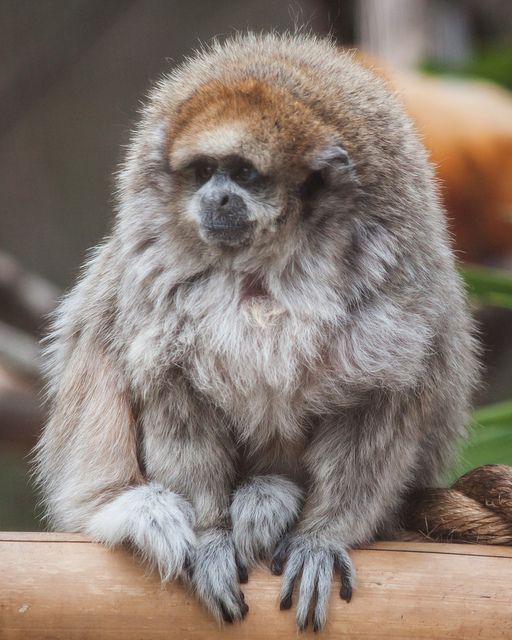Titi monkeys, also known as Callicebus cupreus.
The monkeys are often referred to as New World primates. They are native to the South American forests. A Titi monkey can be easily spotted from its unique physique. The most common ones are brown with a long grey tail and blackface.
The largest Titi monkey weighs less than 2 kgs!
Titi Monkey Facts
- In their initial first 6 months, the father carries the infant. And, invests time in the little Titi monkey’s upbringing. The Titi monkey spends time with the mother only when in need of nursing.

- Fun fact! Titi monkeys perform duets. This is their dominant form of long-distance communication. You name it, they perform solos, duets, and choruses!
- Titi monkeys primarily eat fruits.
- They live in dense vegetation. From wet river banks to inundated forests. They hardly even step down on the forest ground.
- The primates mate for life. They leave their parents at around 2 years of age and look for a mate. After 2 years is when they have grown fully.
- There are over 30 species of Titi monkeys today.
- Titi monkeys use their long tails for balance and warmth.
- Twins are rarely born amongst Titi monkeys.
- Just like humans who hug when they seek comfort, Titi monkeys wrap each other’s tails together. This occurs when they are asleep, or while resting. This phenomenon is called tail twinning. Even in times of stress or contentment, Titi monkeys wrap their tails together.

- Titi monkeys are territorial. They live with their families.
- They are known as springaffe in German because they jump from branch to branch.
Female Titi Monkeys
- Female Titi monkeys as young as two years can conceive and give birth to an offspring.
- A year after being paired with a mate, is when they have a baby Titi monkey.
- An assessment of the female Titi monkey’s endocrine profile was done. They tend to gestate approximately 7 months after giving birth.
- The interbirth interval is shorter after the birth of a stillborn. As well as, after the immediate death of the new born.
Dusky Titi Monkey
- These Titi monkeys are scientifically known as Callicebus Moloch. It is one of the larger species of Titi monkeys. They are monogamous monkeys who mate for life. Dusky Titi monkeys yodel every morning and afternoon to pronounce their territories. They are abundant in the Tambopata forests. Dusky Titi monkeys are as small as squirrels.

- They neither sits on the high branches nor the forest floors, but they are found in the understory of the forest. Amongst the shrubs and trees.
- Dusky Titi monkeys mostly feed on fruits and vegetables. Insects are occasionally eaten.
Activities of Dusky Titi Monkeys
Compared to other Titi monkeys, Dusky Titi monkeys are very lazy. They hardly move around. Dusky Titi monkeys are often cited snacking on fruits, and sitting on branches.
Predators
Dusky Titi monkeys are preys for the Crested and Ornate Hawk Eagles. Even the older species such as Brown Capuchins prey on Dusky Titi monkeys. This is the main reason why they are rarely sited atop of tree branches and stay in dense vegetation.
Bolivian Grey Titi Monkey
- Bolivian Titi monkeys are found in the upper basins of the the Rio Grande and Mamore river.
- They stay in swampy areas.
- Bolivian Titi monkeys are monogamous.
- These Titi monkeys live up to 25 years of age.
- Sited at the Rio Beni basin in Bolivia.
- They have whiteish ear tuffs, and a reddish-brown forehead and crown.
- They are small body primates and have biology similar to humans.
- Read more about Titi Monkeys in Bolivia here!

Red Titi Monkeys
Their tails are mostly used for balancing rather than grasping things. The red Titi monkeys often stay in trees. They socialize with other species. However, their predominant social activity is grooming.
Red Titi monkeys sleep in dense vegetation, or leafy places with vines growing, to be hidden. A group of red Titi monkeys commonly has a nuclear family.  It consists of a monogamous pair and the offspring. These red Titi monkeys once paired up, stay together for life. The father takes care of the young Titi monkeys for up to 4 months. After this, the offspring stays with the family for years until it is independent.
It consists of a monogamous pair and the offspring. These red Titi monkeys once paired up, stay together for life. The father takes care of the young Titi monkeys for up to 4 months. After this, the offspring stays with the family for years until it is independent.
Features of Red Titi Monkey
These monkeys have a light grey forehead. A white band of fur across the crown of the head is their distinctive feature. And agouti i.e fur that has alternate light and dark shades of light brown.
Their legs, chest, and sideburns are reddish. These monkeys have a flat nose. Interestingly, these red Titi monkeys are often referred to as coppery. Because of the fur having a rusty shade to it.
Red Titi Monkey Size
On average, red Titi monkeys weigh up to 1.4 kilograms. They have strong limbs that help them move across branches. Red Titi monkeys stay in the South American rain forests. Across those of Peru, Bolivia, Brazil, and Venezuela.
Diet of Red Titi Monkeys
They eat insects and flowers along with fruits as their staple diet. Also termed as frugivorous species.
Female red Titi monkeys consume more insects while nursing their offspring. Up to 3 generations of offspring are there in a group of red Titi monkeys.
Communication among Red Titi Monkeys
Red Titi monkeys rely heavily on smell and scent while communicating.
To express their anger, they often lash their tails, bare their teeth and sway their bodies. Vocal and visual communication is also seen amongst red Titi monkeys. During fights, red Titi monkeys often trill. These are short squeaks one after the other repeated rapidly.

Trills are heard while they are wrestling, grooming, and when one a monkey has lost its way! The male and female red Titi monkeys often perform duets before or during sunrise. It begins with moaning and ends with honking. During rains, they make no calls. Over time, the duet gets synchronized, with easy transition between parts.
Neighbors often respond to duets- this is a way of marking one’s territory. The duet can last for 5 minutes.
Subspecies of Red Titi Monkeys
Red Titi monkeys have three subspecies. The color of their foreheads is the main distinguishing feature. The three species are:
- Callicebus cupreus discolor– This subspecies of red Titi monkeys. They have a yellowish-brown tinge to their tails. Also known as buffy color. These red Titi monkeys have a buffy color along with their agouti fur across their crown.
- Callicebus cupreus cupreus: These monkeys have a blackish fringe across their crowns.
- Callicebus cupreus orantus: A pale strip runs across their foreheads. Their outer arms and thighs are buffy in color.
Red Titi monkeys are not at risk of extinction. This is mostly because they stay in dense forests far away from human settlements. As well as, these monkeys hardly ever roam around on land. They rest on trees and commute across the forest by jumping from tree to tree. Red Titi monkeys are prey for certain birds and cats.
Raptors and snakes, along with Capuchin monkeys are predators of Titi monkeys. Yet, Titi monkeys coexist with other species. This for their diet and the habitat. The main threat to Titi monkeys is the habitat. Titi monkey’s lives are threatened because of rapid deforestation. As well as, the unforeseen forest fires.
Want to read more about exotic monkeys? check out my post on Baby spider monkeys!
